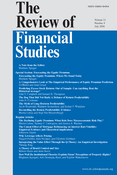-
Views
-
Cite
Cite
John Y. Campbell, Samuel B. Thompson, Predicting Excess Stock Returns Out of Sample: Can Anything Beat the Historical Average?, The Review of Financial Studies, Volume 21, Issue 4, July 2008, Pages 1509–1531, https://doi.org/10.1093/rfs/hhm055
Close - Share Icon Share
Abstract
Goyal and Welch (2007) argue that the historical average excess stock return forecasts future excess stock returns better than regressions of excess returns on predictor variables. In this article, we show that many predictive regressions beat the historical average return, once weak restrictions are imposed on the signs of coefficients and return forecasts. The out-of-sample explanatory power is small, but nonetheless is economically meaningful for mean-variance investors. Even better results can be obtained by imposing the restrictions of steady-state valuation models, thereby removing the need to estimate the average from a short sample of volatile stock returns.




